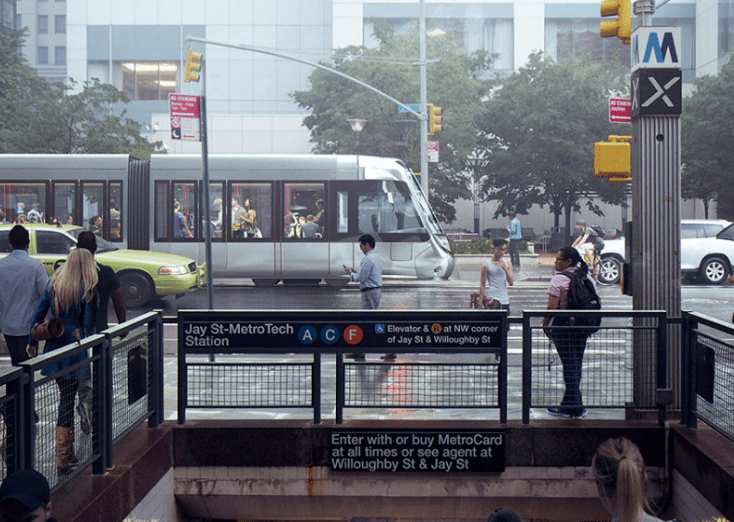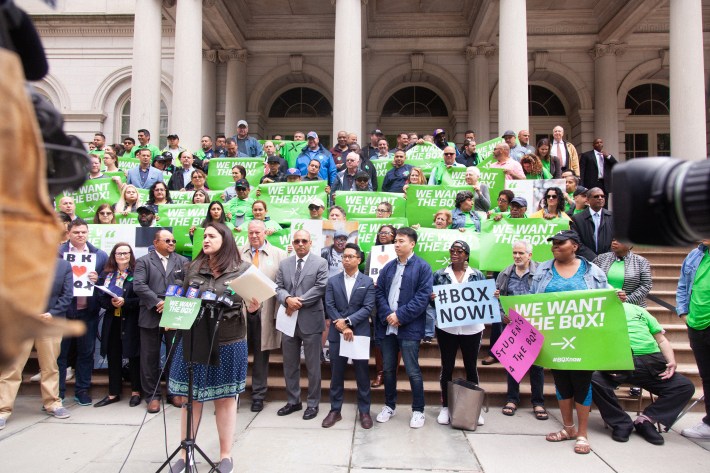Mayor de Blasio needs to just abandon his beloved $2.7-billion BQX streetcar in favor of more cost-effective, more-useful and, frankly less-innovative transit options, opponents said Thursday at the City Council's first trolley task force hearing.
The city is still pushing ahead with the BQX, the 11-mile light rail that would run from Red Hook to Astoria, arguing it would serve transit-starved neighborhoods in Queens and Brooklyn, primarily near public housing, and would pay back part of its staggering construction cost from revenue generated by development that would be spurred along its route. The city also claimed it would enhance the mayor's Vision Zero safety initiative.
But opponents weren't buying it.
“It’s time to stop wasting time, money, and attention on a proposal founded on fiscal misrepresentations and public relations campaigns rather than sound transportation planning,” said David Bragdon, executive director of the TransitCenter. “New York City is in the throes of a transit crisis, one felt most acutely by millions of riders on city streets who put up with the nation’s slowest bus system. ... Through its control of public streets, city government has the power and the obligation to speed up buses and reverse this vicious cycle.”
The mayor originally pitched the BQX in 2016 as a $2.5-billion streetcar running along a 16-mile route from Astoria to Sunset Park (before the city nixed that community) — and claimed the system would entirely pay for itself. But Hizzoner said last summer that the city would need about $1 billion in federal money.
“The BQX is an innovative, forward-looking transportation investment in a key growth corridor that would improve mobility for thousands of New Yorkers,” Christopher Hrones, director of strategic transit initiatives at city Department of Transportation, told the Council's task force.
Here's how the city is making its case — with response from opponents.
Vision Zero
The Department of Transportation argued that the BQX would support the city’s Vision Zero by implementing key street-safety redesigns like sidewalk extensions, medians, and lane reductions.
“Not only a challenge but an opportunity to re-envision how our streets in these neighborhoods can be transformed into spaces that prioritize transit, pedestrians, and bicycles over automobiles,” said Hrones. “We would integrate many of our key Vision Zero tools that we employ to reduce serious injuries and fatalities into the BQX project.”
But the city doesn't need a multibillion-dollar light rail to implement those life-saving safety measures — especially after the spike in traffic fatalities this year.
“Of course the city could do the traffic calming without blowing $3 billion and tearing up a wide swath of the city for 5+ years” said Bike New York’s Jon Orcutt.
But what about a bus?
Officials testified that the city is also studying building out a new Bus Rapid Transit line — also known as Select Bus Service — if the forthcoming BQX environmental review suggests that the trolley isn't viable.
Hrones said an “initial assessment" ranked the BQX on top, but considered bus rapid transit "a second ranking one — and one worthy of further exploration.”
The EDC and DOT plan to begin the Environmental Impact Statement process this fall, which will determine if the mayor’s proposed light rail can in fact generate enough cash to offset some of its costs and benefit a large enough ridership.
If not, the route could be turned into a BRT route — but the $7.5 million the city says it’s already spent on consultants would be down the drain.
Queens Council Member Jimmy Van Bramer, who has long opposed the trolley, held out hope that the environmental review would change the mayor's mind.
“We want better mass transit options, chiefly for residents of public housing," he said. "But ... is it possible you come back at that point and say the (Bus Rapid Transit) is actually the more doable option?”
Other opponents put it more plainly: Why not improve existing service instead of building an entirely new type of service?
"Bus service, which would offer equal or superior transit service, could be implemented far more cheaply, and more quickly, as well," said StreetsPAC's Eric McClure.
But Economic Development Corporation Executive Vice President Seth Myers later explained that the BQX would be better than a bus line because the trolley would raise property values even more than a bus would.
"Studies have shown [Select Bus Service] generates a smaller transit premium," he said. He also claimed an SBS route only saves 30 percent on capital costs — an assertion that went unchecked.
It’s always about parking
One aspect of the project most celebrated by transit and safe-street advocates is that it would require the elimination of 2,000 parking spots along its route.
But even one of the most safe-street-friendly pols in the city council is skeptical that it would be an easy win.
“I’m a supporter [of reducing parking], but I want to hear from NYCHA residents about what they think about removing parking,” said Brooklyn Council Member Carlos Menchaca, whose district includes Sunset Park and Red Hook and also opposed the BQX.
Who is going to pay for it?
When Mayor de Blasio proudly announced the developer-backed streetcar in 2016, he said it would entirely pay for itself through increased property taxes generated by homes and commercial buildings along the route.
But two years later, he said it actually needs a $1-billion check from the federal government.
And with President Trump — who publicly blasted de Blasio when he launched his presidential campaign earlier this month — in office until at least 2021, it seems unlikely that the city will get the cash to have the BQX running by 2029 as planned, said Van Bramer.
“The federal contribution, that’s a change from the beginning. I understand plans change ... but the current occupant [in the White House] is not necessarily the most friendly to New York City," he said. "How do you anticipate overcoming that barrier if we continue to have a hostile occupant in the White House?”
Ahead of the hearing, more than 100 BQX supporters — including Queens Borough President Melinda Katz; Brooklyn Borough President Eric Adams; Jessica Schumer, executive director of advocacy group Friends of the BQX; and local community groups — rallied on the steps of City Hall to push for the light rail.
"The BQX represents exactly the type of bold and visionary thinking our city needs if we are going to continue to grow equitably and increase opportunity for New Yorkers,” said Schumer. “The BQX has the potential to connect this fast-growing corridor and create a new spine of our city through affordable, accessible and efficient mass transit."







